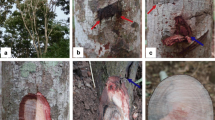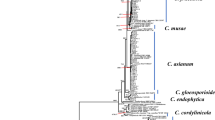Abstract
A serious wilt disease has recently been found on Prosopis cineraria (Ghaf) in Oman and on Dalbergia sissoo (Shisham) in Pakistan. Disease symptoms on both these native, leguminous hosts include vascular discolouration and partial or complete wilt of affected trees. A species of Ceratocystis was consistently isolated from symptomatic material. Morphological comparisons and analyses of DNA sequence data of the ITS, β-tubulin, and EF 1-α gene regions showed that the Ceratocystis isolates obtained from both tree species represent C. manginecans. This is the same pathogen that is causing the devastating mango sudden decline disease in Oman and Pakistan. This is also the same pathogen that has been reported causing a wilting disease on Acacia mangium in Indonesia. Cross inoculation with C. manginecans isolates from P. cineraria, D. sissoo and mango showed that the fungus can cause disease on all three trees.






Similar content being viewed by others
References
Al Adawi AO (2002) The Biology of Diplodia theobromae associated with Mango Sudden Decline Disease in Oman. Dissertation, Sultan Qaboos University
Al Adawi AO, Deadman ML, Al Rawahi AK, Khan AJ, Al Maqbali YM (2003) Diplodia theobromae associated with sudden decline of mango in the Sultanate of Oman. Plant Pathol 52:419
Al Adawi AO, Deadman ML, Al Rawahi AK, Al Maqbali YM, Al Jahwari AA, Al Saadi BA, Al Amri IS, Wingfield MJ (2006) Aetiology and causal agents of mango sudden decline disease in the Sultanate of Oman. Eur J Plant Pathol 116:247–254
Al Adawi AO, Barnes I, Al Jahwari AA, Deadman ML, Wingfield BD, Wingfield MJ (2009) Discovery of a Ceratocystis sp. associated with wilt disease of two native leguminous tree hosts in Oman and Pakistan. Australian Plant Pathology Society meeting (APPS 2009) ‘Plant health management: An integrated approach’. 29 September–1 October 2009
Al Adawi AO, Al Jabri RM, Deadman ML, Barnes I, Wingfield BD, Wingfield MJ (2013) The mango sudden decline pathogen, Ceratocystis manginecans, is vectored by Hypocryphalus mangiferae (Coleoptera: Scolytinae) in Oman. European Journal of Plant Pathology In press
Anderson PK, Cunningham AA, Patel NG, Morales FJ, Epstein PR, Daszak P (2004) Emerging infectious diseases of plants: pathogen pollution, climate change and agrotechnology drivers. Trends Ecol Evol 19:535–544
Atkinson TH, Peck SB (1994) Annotated checklist of the bark and ambrosia beetles (Coleoptera: Platypodidae and Scolytidae) of tropical Southern Florida. Fla Entomol Online 77:313–329
Barnes I, Roux J, Coetzee MPA, Wingfield BD, Wingfield MJ (2001) Characterization of Seiridium spp. associated with Cypress Canker based on B-tubulin and histone sequence. Plant Dis 85:317–321
Barnes I, Roux J, Wingfield BD, Dudzinski MJ, Old KM, Wingfield MJ (2003) Ceratocystis pirilliformis, a new species from Eucalyptus nitens in Australia. Mycologia 95:865–871
Brown K (1991) Biology of Prosopis cineraria (Leguminosae) in the Sultanate of Oman. Dissertation, University of Durham
Brown K (1992) Prosopis cineraria research in Oman. Directorate General of Agricultural Research, Rumais, Ministry of Agriculture and Fisheries, Sultanate of Oman
Butani DK (1993) Mango: Pest Problems. Periodical Expert Book Agency D- 42, Vivek Vihar, Delhi
Castro RS (1960) Contribuicao ao estudo de Hypocryphalus mangiferae (Stebbing, 1914) (Coleoptera, Scolytidae). [Contribution to the study of the “Hypocryphalus mangiferae (Stebbing, 1914)” (Coleopter – Scolytidae) biological cycle and etiology] Ciclo biologico e etiologia. Recife. Tese para concurso de professor livre-docente da 9.a cadeira-entomologia e parasitologia agricolas- da Escola Superior de Agricultura da Universidade Rural de Pernambuco, 54p
Desprez-Loustau ML, Robin C, Buee M, Courtecuisse R, Garbaye J, Suffert F, Sache I, Rizzo DM (2007) The fungal dimension of biological invasions. Trends Ecol Evol 22:472–480
Engelbrecht CJB, Harrington TC (2005) Intersterility, morphology and taxonomy of Ceratocystis fimbriata on sweet potato, cacao and sycamore. Mycologia 97:57–69
Glass NL, Donaldson GC (1995) Development of primer sets designed for use with the PCR to amplify conserved genes from filamentous Ascomycetes. Appl Environ Microbiol 61:1323–1330
Halsted BD, Fairchild DG (1891) Sweet-potato black rot. J Mycol 7:1–11
Heath RN, Wingfield MJ, Van Wyk M, Roux J (2009) Insect Associates of Ceratocystis albifundus and Patterns of Association in a Native Savanna Ecosystem in South Africa. Environ Entomol 38:356–364
CAB International (2001) Ceratocystis fimbriata (original text by Harrington, T. C. and Baker, C.). In: Crop protection compendium. CAB International, Wallingford
Jacobs K, Bergdahl DR, Wingfield MJ, Halik S, Seifert KA, Bright DE, Wingfield BD (2004) Leptographium wingfieldii introduced into North America and found associated with exotic Tomicus piniperda and native bark beetles. Mycol Res 108:411–418
Johnson JA, Harrington TC, Engelbrecht CJB (2005) Phylogeny and taxonomy of the North American clade of the Ceratocystis fimbriata complex. Mycologia 97:1067–1092
Kazmi MR, Fateh FS, Majeed K, Kashkhely AM, Hussain I, Ahmad I, Jabeen A (2005) Incidence and etiology of mango sudden death phenomenon in Pakistan. Pak J Phytopathol 17:154–158
Khan SH, Idrees M, Muhammad F, Mahmood A, Zaidi SH (2004) Incidence of Shisham (Dalbergia sissoo Roxb.) decline and in vitro response of isolated fungus spp. to various fungicides. Int J Agric Biol 6:611–614
Kile GA (1993) Plant diseases caused by species of Ceratocystis sensu stricto and Chalara. In: Wingfield MJ, Seifert KA, Webber JF (eds) Ceratocystis and Ophiostoma: Taxonomy, Ecology and Pathogenicity. APS Press, St Paul, pp 173–183
Ko KS, Jung HS (2002) Three nonorthologous ITS1 types are present in a polypore fungus Trichaptum abietinum. Mol Phylogenet Evol 23:112–122
Lieckfeldt E, Seifert K (2000) An evaluation of the use of ITS sequences in the taxonomy of the Hypocreales. Stud Mycol 45:35–44
Malik MT, Khan SM, Dasti AA, Kazmi MR (2005) First record of Ceratocystis fimbriata, causal organism of mango sudden death in Pakistan. Pak J Phytopathol 17:187–191
Moller WJ, DeVay JE (1968a) Carrot as a species-selective isolation medium for Ceratocystis fimbriata. Phytopathology 58:123–124
Moller WJ, DeVay JE (1968b) Insect transmission of Ceratocystis fimbriata in deciduous fruit orchards. Phytopathology 58:1499–1508
Morris MJ, Wingfield MJ, De Beer C (1993) Gummosis and wilt of Acacia mearnsii in South Africa caused Ceratocystis fimbriata. Plant Pathol 42:814–817
Nylander JAA (2004) MrModeltest v2. Program distributed by the author. Evolutionary Biology Centre, Uppsala University
O’Donnell K, Cigelnik E (1997) Two divergent intragenomic rDNA ITS2 types within a monophyletic lineage of the fungus Fusarium are nonorthologous. Mol Phylogenet Evol 7:103–116
Pannecoucque J, Höfte M (2009) Detection of rDNA ITS polymorphism in Rhizoctonia solani AG 2-1 isolates. Mycologia 101:26–33
Pena JE, Mohyuddin AI (1997) Insect Pests. In: Litz RE (ed) The Mango: Botany, Production and Uses. CAB International, Wallingford, pp 327–362
Ploetz RC (2003) Diseases of Mango. In: Ploetz RC (ed) Diseases of Tropical Fruit Crops. CAB International, Wallingford, pp 327–363
Poussio GB, Kazmi MR, Akem C, Fateh FS (2010) First record of Ceratocystis fimbriata associated with shisham (Dalbergia sissoo) decline in Pakistan. Australas Plant Dis Notes 5:63–65
Rannala B, Yang Z (1996) Probability distribution of molecular evolutionary trees: a new method of phylogenetic inference. J Mol Evol 43:304–311
Rodas CA, Roux J, van Wyk M, Wingfield BD, Wingfield MJ (2008) Ceratocystis neglecta sp. nov., infecting Eucalyptus trees in Colombia. Fungal Divers 28:73–84
Ronquist F, Huelsenbeck JP (2003) MrBayes3: Bayesian phylogenetic inference under mixed models. Bioinformatics 19:1572–1574
Roux J, Wingfield MJ (2009) Ceratocystis species: emerging pathogens of non-native plantation Eucalyptus and Acacia species. South Forest 71:115–120
Roy BA (2001) Patterns of association between crucifers and their flower-mimic pathogens: Host jumps are more common than co-evolution or co-speciation. Evolution 55:41–53
Schoch CL, Seifert KA, Huhndorf S, Robert V, Spouge JL, Levesque CA, Chen W, Fungal Barcoding Consortium (2012) Nuclear ribosomal internal transcribed spacer (ITS) region as a universal DNA barcode marker for Fungi. Proc Nat Acad Sci USA 109:6241–6246
Seifert KA (2009) Progress towards DNA barcoding of fungi. Mol Ecol Res, 9(Suppl. 1), pp. 83-89. doi:10.1111/j.1755-0998.2009.02635.x
Slippers B, Stenlid J, Wingfield MJ (2005) Emerging pathogens: fungal host jumps following anthropogenic introduction. Trends Ecol Evol 20:420–421
Swofford DL (2002) PAUP*. Phylogenetic Analysis Using Parsimony (*and other methods). Version 4. Sinauer Associates, Sunderland
Tamura K, Peterson D, Peterson N, Stecher G, Nei M, Kumar S (2011) MEGA5: Molecular Evolutionary Genetics Analysis using Maximum Likelihood, Evolutionary Distance, and Maximum Parsimony Methods. Mol Biol Evol 28:2731–2739
Tantau H, Hoque MI, Sarker RH, Muhlbach HP (2005) 16S rDNA sequence analysis of bacterial isolates from dieback affected Sissoo trees (Dalbergia sissoo Roxb.) in Bangladesh. J Phytopathol 153:517–521
Tarigan M, Roux J, Van Wyk M, Tjahjono B, Wingfield MJ (2011) A new wilt and die-back disease of Acacia mangium associated with Ceratocystis manginecans and C. acaciivora sp. nov. in Indonesia. S Afr J Bot 77:292–304
Upadhyay HP (1981) A monograph of Ceratocystis and Ceratocystiopsis. University of Georgia Press, Athens
Van Wyk M, Al Adawi AO, Khan IA, Deadman ML, Al Jahwari A, Wingfield BD, Ploetz RC, Wingfield MJ (2007) Ceratocystis manginecans sp. nov., causal disease of a destructive mango wilt disease in Oman and Pakistan. Fungal Divers 27:213–230
Van Wyk M, Wingfield BD, Mohali S, Wingfield MJ (2009) Ceratocystis fimbriatomima, a new species in the C. fimbriata sensu lato complex isolated from Eucalyptus trees in Venezuela. Fungal Divers 34:173–183
Van Wyk M, Wingfield BD, Marin M, Wingfield MJ (2010) New Ceratocystis species infecting coffee, cacao, citrus and native trees in Colombia. Fungal Divers 40:103–117
Van Wyk M, Wingfield BD, Wingfield MJ (2011) Four new Ceratocystis spp. associated with wounds on Eucalyptus, Schizolobium and Terminalia trees in Ecuador. Fungal Divers 40:103–117
Viegas AP (1960) Seca da mangueira (Mango Wilt). Bragantia 19:163–182
White TJ, Burns T, Lee S, Taylor J (1990) Amplification and direct sequencing of fungal ribosomal RNA genes for phylogenetics. In: Innis MA, Gelfand DH, Sninsky JJ, White TJ (eds) PCR protocols: A sequencing guide to methods and applications. Academic, San Diego, pp 315–322
Wingfield MJ, De Beer C, Visser C, Wingfield BD (1996) A new Ceratocystis species defined using morphological and ribosomal DNA sequence comparisons. Syst Appl Microbiol 19:191–202
Wingfield MJ, Slippers B, Wingfield BD (2010) Novel association between pathogens, insects and tree species threaten world forests. N Z J For Sci 40:S95–S103
Woolhouse MEJ, Haydon DT, Antia R (2005) Emerging pathogens: the epidemiology and evolution of species jumps. Trends Ecol Evol 20:238–244
Acknowledgement
We thank members of the Tree Protection Co-operative Programme (TPCP), University of Pretoria, South Africa, and the Ministry of Agriculture and Fisheries, Oman, for funding and providing facilities to conduct this study. We also thank the Nuclear Institute for Agriculture and Biology (NIAB) for facilitating surveys and shisham sample collection in Pakistan.
Author information
Authors and Affiliations
Corresponding author
Rights and permissions
About this article
Cite this article
Al Adawi, A.O., Barnes, I., Khan, I.A. et al. Ceratocystis manginecans associated with a serious wilt disease of two native legume trees in Oman and Pakistan. Australasian Plant Pathol. 42, 179–193 (2013). https://doi.org/10.1007/s13313-012-0196-5
Received:
Accepted:
Published:
Issue Date:
DOI: https://doi.org/10.1007/s13313-012-0196-5




